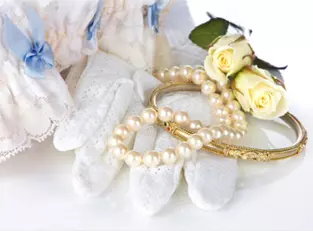WEDDING HISTORY & FAQs

Matrimonial Myth Busters
Uncovering Popular & Uncanny Wedding Traditions From Ireland To Japan
By: Keely Coxon
The other day, I found myself flipping nonchalantly through a wedding book, as do many writers of my job description during their spare time (hey, we have to come up with article ideas somehow!). Mid-flip on one page, a funny-looking rhyme caught my eye, and proceeded to snare me into reading the ensuing two paragraphs under it. What, pray tell, was this interesting little ditty about? A peculiar wedding myth from Ireland, regarding the “proper” days of the week to get married on. It went a little like, “Monday through Thursday is great, but if you get married on Friday or Saturday, you better watch yourself, and Sunday equals no way, Jose!”
Okay, so it was definitely a bit more eloquent than my hackneyed version, but still, the general premise of having “days” of the week to get married on absolutely fascinated me. I don’t know about you, but I can be pretty superstitious. As it turns out, in this particular case, traditional Irish weddings may go on for two to three days, and since Sunday is their holy day (many Irish remain devoutly religious), the multi-day wedding “party” puts Sunday services at risk if it begins as close as Friday or Saturday. Ah hah!
So, being my usual curious self, I decided to search out other striking wedding myths that many of us have likely never heard, and chose a few of my favorite to share below.
As a disclaimer, I also did some background research to shed light on the truthfulness of the myths in this article, and can happily report that no particular month, dress color or other matrimonial talisman is going to bode better or worse for a bride, at least not to the knowledge of any current research, anyway. These myths are simply meant as a little something to spice up an otherwise mediocre winter weekend, so go ahead, read on, and don’t worry!
Let’s begin with the “usual” wedding myths, those that most of us are probably familiar with. Just about anyone in the Western hemisphere can throw the “Something old, something new, something borrowed and something blue” rhyme at a bride-to-be. It’s one of the oldest in the book. And yes, a good number of brides do still go out and find a collaboration of things meeting the four descriptions to wear on their wedding day.
And, of course, many people think that it is bad luck for the groom to see the bride the night before the wedding. However, this could make any last-minute rehearsal dinners a bit awkward, eh? It’s also sometimes considered bad luck for the groom to see the bride in her dress before the big day. Considering the absolute loathing that most guys share for shopping, however, this seemingly ridiculous old-wives’ tale is probably one of the most unintentionally-followed!
Slightly more interesting myths and traditions:
- Here in North America, the most popular wedding dress color is invariably a shade of white or cream. However, in other parts of the world, the tradition can be drastically different; take, for example, many Asian countries, which list red as the most popular (and “luckiest”) wedding garment color, or certain West African countries, where ceremonial outfits created from Asooke or Kente cloth prevail.
- In older, traditional Greek weddings, it was common for guests to visit the couple’s new home during the week before the ceremony, and leave presents on their bed.
- Historically, single Polish girls would always wear their hair in a single braid. The night before their wedding, their mother and/or closest female friends would undo their single braid and re-do it into two plaits.
- Many traditional Irish couples would spend their first year after marriage in a phase called “handfasting.” The basic jist of the situation was that, after one year, if neither was happy in the marriage, they could both walk away, no strings attached.
- In historical Anglo-Saxon weddings, especially those of the 18th and 19th centuries, the whiter the icing on a couple’s cake was, the more “pure” the bride was thought to be. In reality, all it actually meant was that her family was quite wealthy, since whiter icing required much more sugar than its clear counterpart (a “glaze”), and sugar was hard to come by in those times.
- In Cajun wedding tradition, the bride and groom nearly always have the first dance at their reception. Afterwards, it is custom for members of the opposite gender to dance with either of them, but only after the guest pins money to the bride or groom’s wedding outfit! Before the time of massive wedding gifts and affordable travel, this money helped defray the cost of the new couples’ honeymoon and assisted in setting up their first household.
Good gracious! From handfasting to money-pinning, some of these myths and traditions absolutely blew my mind. And we North Americans think we have it rough, simply having to track down items that are old, new, borrowed or blue. I will never complain again!





